


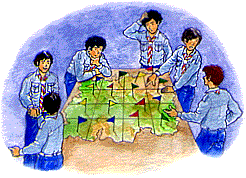
Type of activity: Game
Duration: 2 hours
Place: Troop meeting place
Participants: The Troop
The 19th World Scout Jamboree invites Patrols from all countries to experience
a moment of togetherness allowing you to get to share and get to know the
richness and variety of our world's cultures. It is an excellent opportunity
for us to renew our commitment to world peace. In keeping with this objective,
a number of workshops relating to peace and inter-cultural understanding
have been planned for this event and will be open to Jamboree participants.
We present this game to you and your Troop as a means of introducing
you to the theme, and so that you can explore it.
Introduction
The seeds of peace are within us and our daily lives. We are frequently
forced into conflictive situations which draw us into arguments with others,
so it is important for each of us to ask himself: What is the major obstacle
to finding a solution? How do I behave at these times? What are my strategies?
How do others react? These are some of the questions you will have to answer
when you find yourselves in the fictitious circumstances of our game, DISPUTED
TERRITORIES.
Before the activity
To prepare this game, the adults in charge will have to follow these
steps:
1.Make up a map of plots of land according to the following instructions:
a) On a piece of cardboard 100 cm by 50 cm draw the map of an imaginary
campsite. To trace the lines you can guide yourselves using the information
found in Appendix 4. We recommend that you include on the board the geographical
characteristics required by the game, such as the ravine in sector A1, the
old barn in B4, the waterfall of C3 and the lagoon of A3.
b) 16 territories have to be clearly defined, and labelled with their
corresponding numbers (Appendix 1).
c) Following the suggestions in Appendix 1, small
coloured flags (i.e. blue, yellow, red, green) are placed in each plot.
These can be made from pins and bits of coloured cardboard or cloth. The
idea is that it should be easy to change their position on the board.
2. Those in charge should prepare four different copies of the Backgrounds
with the information found in Appendix 4
(one for each Patrol or team).
3. In addition, a copy of the "Personal Evaluation Guidelines"
from Appendix 3 has to be prepared for all participants.
NOTE: It is of fundamental importance that the Scouts do not know the
rules before they start the game.
The Game
| 1. |
The game consists of four teams. If the Troop is composed of 4 Patrols,
each one constitutes a team and is allotted a colour (blue, yellow, red,
green). |
| 2. |
The activity leader gives an introduction, outlining this fictitious situation:
The Patrols are all camping together, but each one has decided on a specific
aim which depends on the natural conditions of the local terrain. |
| 3. |
Then, the adults in charge display the board with the defined areas and
small flags, explaining that this is the proposed campsite. The teams can
immediately see that their plots of land are dispersed over different parts
of the board. |
| 4. |
They hand out to each Patrol the corresponding backgrounds with characteristics
of the land they own and their goal in the imaginary camp. None of the
teams must know the background of the others. |
| 5. |
Blank pages and pencils must be at hand so that the Patrols can record their
strategies, agreements and exchanges of territory. Each team should choose
a secretary. |
| 6. |
The activity leader informs everyone that there will be enough time for
each Patrol to read their background and work out a plan of action to achieve
their goal. These will be conflicting interests, and the adults in charge
must therefore ask the players to find the best way of resolving their conflicts.
Now each Patrol has to negotiate with their neighbours, trying to obtain
the territories that their plan of action demands. |
The necessary transactions will be freely developed amongst the teams. The
idea is that each one tries to get as close as possible to their proposed
goal, even if this means they do not get hold of all the required territories.
Suggested duration: 30 minutes.
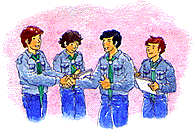 7. Once time available for negotiations has run out, they are finalised
and the adults in charge distribute the "Personal Evaluation Guidelines"
(Appendix 3) to all the participants so they can answer
the questionnaire. 7. Once time available for negotiations has run out, they are finalised
and the adults in charge distribute the "Personal Evaluation Guidelines"
(Appendix 3) to all the participants so they can answer
the questionnaire.
Suggested duration: 5 to 10 minutes.
8. At the end of this stage, the activity leader invites the youngsters
to present their results. Each team tells the Troop what their initial aim
was, specifying whatever they managed to achieve at the end of the negotiation
period. The adults in charge can also go through the questions of the evaluation
guidelines aloud and encourage the Scouts to express their opinions freely.
Suggested duration: 20 minutes.
| 9. |
The activity leader describes the PROPOSED SOLUTION (see
Appendix 2) so that everyone can visualise it. |
| 10. |
Finally, he/she invites the Patrols to compare the solution proposed
in Appendix 2 with the results of the Troops' negotiations.
You can motivate the discussion by asking questions such as:
 How are the two alternatives different or similar? How are the two alternatives different or similar?
 Is the solution proposed by Appendix 2
fairer than the result obtained by the Troop or not?
Is the solution proposed by Appendix 2
fairer than the result obtained by the Troop or not?
 What other solution can be formulated in order for all teams to reach their
objectives?
What other solution can be formulated in order for all teams to reach their
objectives?
|
We hope that this game has contributed to a greater understanding within
the Troop of how to constructively confront conflicts that might arise in
the future. We must go on and continue the search for new methods of co-operation,
helping us to be prepared to sacrifice certain expectations in order to
achieve others.
Appendix 1
DESIGNATION OF TERRITORIES

Appendix 2
SUGGESTED SOLUTION
To satisfy all teams with some degree of sacrifice:
| 1. |
Blue Team: acquires four adjacent sites, maintaining A1 to build the bridge,
however, does not keep A2 and B2 as desired. |
| 2. |
Yellow Team: acquires three sites adjacent to A3, maintaining the possibility
of building the Nature Trail in the desired sector, but does not get A4
and B4. |
| 3. |
Red Team: succeeds in uniting 6 sites and is left with the crucial sector
for the construction of a water wheel. Does not get B3. |
| 4. |
Green Team: is left with the two sites that it needs, keeping B4 to install
their storage room. |

Appendix 3
PERSONAL EVALUATION GUIDELINES
1. How would you qualify the results your team got?
a) Very good
d)
Deficient |
b) Good
e)
Bad |
c) Regular |
2. Why do you qualify them that way?
3. According to your criteria,
your team:
| a) Won |
b) Drew |
c) Lost |
4. Why do you see it that way?
5. Were you left with the territories necessary
for your goal?
6. Did you acquire the number of sites you
wanted, including the adjacent ones?
7. How do you perceive the relationship
between that acquired and that handed over by your team?
a) Acquired more than what they handed over
c) Acquired less than what they
handed over |
b) Acquired as much as what they handed
over |
8. How did you deal with confrontations?
- Arguing your position
- Giving in to the pressures
of others
- Negotiating, trying to reach terms of compromise
- Other ways, give details:
9. How did you feel applying that strategy??
Appendix 4
BACKGROUND 1  BLUE TEAM BLUE TEAM
The campsite is characterised by an irregular topography. You think this
is an opportunity to develop a series of raised constructions, which you
have been preparing for throughout the whole year.
The sites that have been allocated to you are dispersed across the board.
These are A1, C4, D1 and D2..
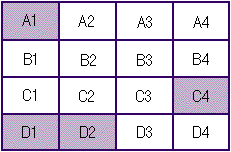
You have found out that the sites A1, B1, A2 and B2 are flat and that they
permit the implementation of the desired constructions. Moreover, in A1
there is a ravine over which it is possible to construct a bridge, which
is the most important aim for the Patrol.
BACKGROUND 2  YELLOW TEAM YELLOW TEAM
You have been preparing yourselves throughout the whole year to build
a Nature Trail in your sector at this camp. You are planning to place signs
along the trail, naming all the species that are found there.
The sites that have been allocated are A3, B1, C1 and C2.
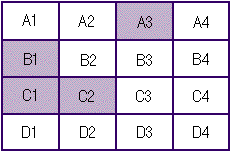
In site A3 there is a wood where the camp's only lagoon is to be found
and there it is possible to construct a natural observatory for animals.
This place is fundamental to the success of the Patrol's aims. You would
also like to get sites B3, A4 and B4.
BACKGROUND 3  RED TEAM RED TEAM
You have been preparing a technological project to create electric power.
The idea is to bring light to a sector by installing a dynamo connected
to a water wheel.
The sites that have been defined are A4, B2, C3 and D3.
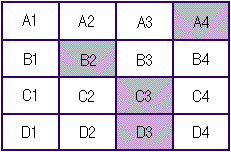
In site C3 there is an ideal waterfall for the installation of this machinery.
Moreover, the dynamo has the capacity to illuminate a total of 6 sites,
hence it would be ideal to create a complete block, adding sites B3, C2
and D2.
BACKGROUND 4  GREEN TEAM GREEN TEAM
Your aim is to carry out services for the local community and you have
made a series of contacts with their representatives.
The sites that have been defined for you are A2, B3, B4 and D4.
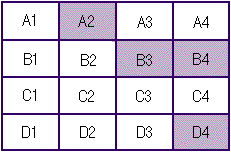
In order to achieve your aims, you need a spacious sector where you can
install a storage room for materials. You do not need 4 sites, but you should
keep B4 where there is an old barn that would be useful as a storage room.
Ideally you would also obtain sites adjacent to B4, that is, A4 and C4.



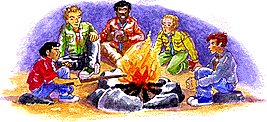 Type of Activity: Workshop Type of Activity: Workshop
Duration: 2 hours
Place: Troop meeting place or at camp
Participants: The Troop
Nowadays, there is a consensus in the world that all people are equal
in dignity and rights. However, they are fundamentally different in their
cultural and personal expressions. Within this context peace is of great
importance as the only atmosphere in which it is possible to achieve happiness,
and which permits individual development at the same time as the expression
of diversity.
The 19th World Scout Jamboree is an event that aims to unite young people
from different countries under the theme "Building Peace Together".
That is why we want each one of you to reflect and ask yourselves questions
such as: What does peace mean? How is it possible to promote it within our
own surroundings? Through this workshop, we suggest a COMMITMENT TO PEACE
which is already practised by other Scouts from around the planet.
Before the activity
 The adults in charge must take into account that the workshop requires
a piece of paper, a pen and an envelope for each participant. A
flip chart will also be needed. The adults in charge must take into account that the workshop requires
a piece of paper, a pen and an envelope for each participant. A
flip chart will also be needed.
 They should prepare a presentation in advance. For this, they can collect
photographs and articles from newspapers and magazines, which describe current
events, where peace is under threat. They should prepare a presentation in advance. For this, they can collect
photographs and articles from newspapers and magazines, which describe current
events, where peace is under threat.
We recommend covering an extensive variety of conflicts, including those
that affect the international, regional, national, local and /or personal
sphere.
The activity
1. Presentation. The Troop meets in plenary session and
those in charge share the information they have compiled. Our suggestion
is to consider the order from a global to a personal sphere, demonstrating
that peace is indispensable in all levels. The participants can feel free
to join the dialogue, and together they can identify all the different meanings
of the concept. These should be noted down on the flip chart. To facilitate
the conversation, the activity leader might suggest some examples:
 Peace as the absence of war between nations Peace as the absence of war between nations
 Peace as a truce between opposition gangs Peace as a truce between opposition gangs
 Peace as a state of harmony between the inhabitants of a country Peace as a state of harmony between the inhabitants of a country
 Peace as the expression of brotherhood between school mates Peace as the expression of brotherhood between school mates
 Peace as a calm and cordial environment within the family Peace as a calm and cordial environment within the family
 Peace as a manifestation of internal happiness e.g. when one says "I
am at peace with myself" Peace as a manifestation of internal happiness e.g. when one says "I
am at peace with myself"
2. The adults in charge ask the participants to tell the Troop why they
think peace is important. When all have spoken their minds they strengthen
the idea which is expressed in the introduction of this material concluding
that happiness is only possible within an environment of peace. Can
we reach a state of happiness if we are immersed into constant conflicts
such as wars, confrontations, and discussions?
3. By brainstorming ideas the participants should come up with
concrete actions to generate a peaceful atmosphere. The challenge consists
of imagining what can be done in each case. This is also registered on the
flip chart.
Suggested duration: 20 minutes
4. After this reflection, the Troop leaders invite the participants to
make a COMMITMENT TO PEACE. In order for the Scouts to be able to
formulate a commitment, they ask them to concentrate on the personal level.
Next, the following instructions are handed out:
 Find an area where peace is of special importance
e.g. coexistence with friends or the family. Find an area where peace is of special importance
e.g. coexistence with friends or the family.
 Establish your objective and concrete actions for its
realisation. The adults in charge should make sure that the participants
understand both steps. For example, if a person wants to be more receptive,
it is necessary to improve his or her communication skills. Establish your objective and concrete actions for its
realisation. The adults in charge should make sure that the participants
understand both steps. For example, if a person wants to be more receptive,
it is necessary to improve his or her communication skills.
If suitable, cases can be quoted:
a) Someone who wants to commit himself/herself to the struggle for peace
in the world must think of an alternative that allows him/her to unite his/her
actions with those of others in a collective effort e.g. the incorporation
into an organisation working to promote peace.
b) Someone who wants to make a commitment that is manifested in a class
at school must identify the attitudes of his/her schoolmates that offend
and those that make him/her feel good. Next, he/she has to think about his/her
different reactions in each situation. Lastly, concrete actions should be
established to collaborate to the creation of an environment of peace such
as respecting the other when he or she is expressing his or her opinion,
receiving criticisms in a positive manner, promoting negotiation during
decision making, not threatening physically or verbally under any circumstance,
etc.
 Fix the timing to carry out concrete actions which allow
the realisation of the objective. It does not have to be strict, but clear
e.g. 3 weeks, 2 months or 1 year. Fix the timing to carry out concrete actions which allow
the realisation of the objective. It does not have to be strict, but clear
e.g. 3 weeks, 2 months or 1 year.
We suggest planning each action previously and establishing a deadline
for each stage.
Suggested duration: 15 minutes.
5. Personal activity. The adults in charge hand out pen and paper
to each of the participants. They write down their COMMITMENT TO PEACE,
the concrete actions, and deadlines. It is fundamental that the Scouts feel
free to choose a place to calmly draw up the commitment.
During this time, the Troop leaders should be at reach for any question.
The participants can also resolve doubts between themselves, in couples
or groups of three or four. There is nothing to stop people who want to
make a joint commitment.
Suggested duration: 15 minutes.
6. Patrol activity. When all have finished, the activity leader
separately invites the Patrols to meet. Accompanied by an adult in charge,
the members share their respective commitment in turns. We recommend allowing
between 2 or 3 minutes for each person and a moment extra so that the rest
of the Patrol can ask questions.
NOTE: The questions might help each one to clarify their ideas, in order
to gather further detail and complete his or her commitment. The exchange
will also allow analysis as to what extent an objective is realistic.
Suggested duration: 30 minutes.
7. Troop activity. The Patrols meet again in plenary session.
The activity leader asks if there are voluntaries that wish to present their
commitment to the rest of the Troop. The listeners can ask questions or
make constructive suggestions.
Those in charge signal that all can count on support and the help from
his/her Patrol or Troop to reach their objective.
NOTE: Experience has shown that a debate might be produced which questions
whether a determined objective, action or date is feasible. With a lot of
care those in charge should make sure that it all does not end up being
a whole meeting focused on one single individual.
To conclude, the Troop leaders emphasise that this cause is personal:
each one is responsible for his/her commitment. That is why it is a special
challenge.
Suggested duration: 20 minutes.
8. Patrol activity. The Patrols meet again separately. Each Scout
receives a small envelope where he or she should put his/her commitment.
After it is sealed the name of the person should be written on it. The activity
leader picks up all the envelopes and puts them all in the Troop archive,
where it is kept for the youngsters.
Observations for the adults in charge
 It is important to notice that the participants will have to reveal
a lot about themselves when writing the COMMITMENT TO PEACE. Therefore,
they should not be forced to share it with the rest of the Patrol or the
Troop. It is important to notice that the participants will have to reveal
a lot about themselves when writing the COMMITMENT TO PEACE. Therefore,
they should not be forced to share it with the rest of the Patrol or the
Troop.
 It is important to plan a follow up during the next weeks. This
can be organised informally, for example, asking some Scouts: "How
has your commitment been going?" It can also be prepared formally,
fixing a date for a meeting where the participants comment on their progress. It is important to plan a follow up during the next weeks. This
can be organised informally, for example, asking some Scouts: "How
has your commitment been going?" It can also be prepared formally,
fixing a date for a meeting where the participants comment on their progress.
 We recommend personal meetings with each one of the youths.
The idea is to motivate them so that they examine their objective periodically
and make changes. In any case, the follow up should not become a mechanical
activity. We recommend personal meetings with each one of the youths.
The idea is to motivate them so that they examine their objective periodically
and make changes. In any case, the follow up should not become a mechanical
activity.
We hope that this activity has familiarised you with the different dimensions
of peace. The idea is to understand that the building of peace is a task
that we can collaborate on day by day, by putting our values into practice.
This activity has been selected and adapted from the book
"Games for peace and Human Understanding", published by the Asociación
de Guías y Scouts de Chile.

BACK
UP
[The Hightway of Valle
Verde][Caribbean Pirates] |